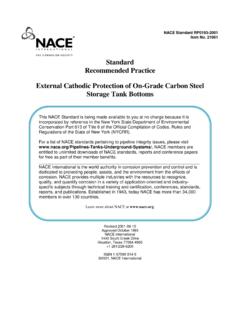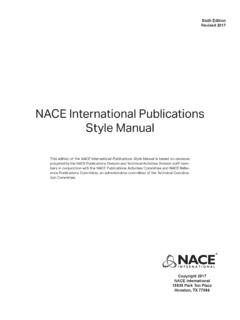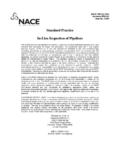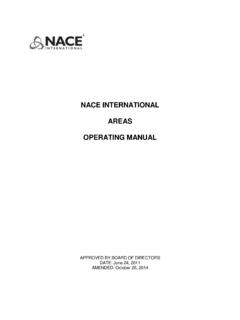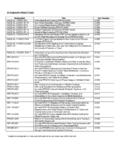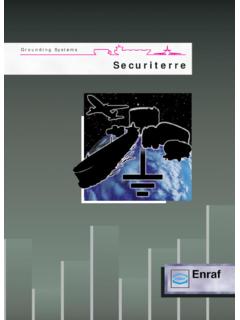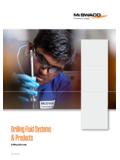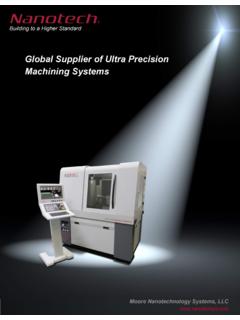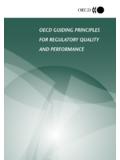Transcription of Standard Test Method Measurement Techniques …
1 Standard Test Method Measurement Techniques Related to Criteria for Cathodic Protection on Underground or Submerged Metallic Piping Systems Revised 2012-06-23 Reaffirmed 2002-04-11 Approved 1997-12-22 NACE International 1440 South Creek Drive Houston, TX 77084-4906 +1 281-228-6200 ISBN 1-57590-047-5 2012, NACE Internationa NACE Standard TM0497-2012 Item No. 21231 This NACE Standard is being made available to you at no charge because it is incorporated by reference in the New York State Department of Environmental Conservation Part 613 of Title 6 of the Official Compilation of Codes, Rules and Regulations of the State of New York (NYCRR).
2 For a list of NACE standards pertaining to pipeline integrity issues, please visit NACE members are entitled to unlimited downloads of NACE standards , reports and conference papers for free as part of their member benefits. _____ NACE International is the world authority in corrosion prevention and control and is dedicated to protecting people, assets, and the environment from the effects of corrosion. NACE provides multiple industries with the resources to recognize, qualify, and quantify corrosion in a variety of application-oriented and industry-specific subjects through technical training and certification, conferences, standards , reports, and publications.
3 Established in 1943, today NACE has more than 34,000 members in over 130 countries. Learn more about NACE at TM0497-2012 ii NACE International This NACE International Standard represents a consensus of those individual members who have reviewed this document, its scope, and provisions. Its acceptance does not in any respect preclude anyone, whether he or she has adopted the Standard or not, from manufacturing, marketing, purchasing, or using products, processes, or procedures not in conformance with this Standard .
4 Nothing contained in this NACE International Standard is to be construed as granting any right, by implication or otherwise, to manufacture, sell, or use in connection with any Method , apparatus, or product covered by Letters Patent, or as indemnifying or protecting anyone against liability for infringement of Letters Patent. This Standard represents minimum requirements and should in no way be interpreted as a restriction on the use of better procedures or materials. Neither is this Standard intended to apply in all cases relating to the subject.
5 Unpredictable circumstances may negate the usefulness of this Standard in specific instances. NACE International assumes no responsibility for the interpretation or use of this Standard by other parties and accepts responsibility for only those official NACE International interpretations issued by NACE International in accordance with its governing procedures and policies which preclude the issuance of interpretations by individual volunteers. Users of this NACE International Standard are responsible for reviewing appropriate health, safety, environmental, and regulatory documents and for determining their applicability in relation to this Standard prior to its use.
6 This NACE International Standard may not necessarily address all potential health and safety problems or environmental hazards associated with the use of materials, equipment, and/or operations detailed or referred to within this Standard . Users of this NACE International Standard are also responsible for establishing appropriate health, safety, and environmental protection practices, in consultation with appropriate regulatory authorities if necessary, to achieve compliance with any existing applicable regulatory requirements prior to the use of this Standard .
7 CAUTIONARY NOTICE: NACE International standards are subject to periodic review, and may be revised or withdrawn at any time in accordance with NACE technical committee procedures. NACE International requires that action be taken to reaffirm, revise, or withdraw this Standard no later than five years from the date of initial publication and subsequently from the date of each reaffirmation or revision. The user is cautioned to obtain the latest edition. Purchasers of NACE International standards may receive current information on all standards and other NACE International publications by contacting the NACE International FirstService Department, 1440 South Creek Dr.
8 , Houston, Texas 77084-4906 (telephone +1 281-228-6200). l TM0497-2012 NACE International i _____ Foreword This NACE International Standard test Method provides descriptions of the Measurement Techniques and cautionary measures most commonly used on underground and submerged piping other than offshore piping to determine whether a specific criterion has been met at a test site. Descriptions of Measurement Techniques and cautionary measures used on offshore pipelines and structures can be found in NACE SP0607/ISO 15589-21 for offshore pipelines, and SP01762 for offshore structures.
9 This Standard includes only those Measurement Techniques that relate to the criteria or special conditions, such as a net protective current, contained in NACE This Standard is intended for use by corrosion control personnel concerned with the corrosion of underground or submerged piping systems that transport oil, gas, water, or other fluids. The Measurement Techniques described require that the measurements be made in the field. Because the measurements are obtained under widely varying circumstances of field conditions and pipeline design, this Standard is not as prescriptive as those NACE Standard test methods that use laboratory measurements.
10 Instead, this Standard gives the user latitude to make testing decisions in the field based on the technical facts available. This Standard contains instrumentation and general Measurement guidelines. It includes methods for voltage drop considerations when structure-to-electrolyte potential measurements are made and provides guidance to minimize incorrect data from being collected and used. The Measurement Techniques provided in this Standard were compiled from information submitted by committee members and others with expertise on the subject.
